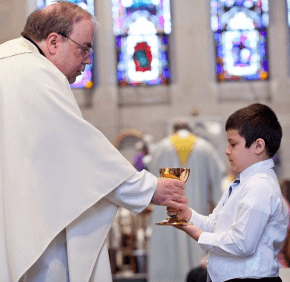By Elizabeth Lowe
Elowe@CatholicReview.org
Preparing children for their first Communion requires instruction about how the bread and wine become the body and blood of Jesus and how to receive the Eucharist properly, according to those involved with sacramental preparation.
Explaining transubstantiation, the belief that the bread and wine become the body and blood of Jesus, to children is complex, said Theresa Konitzer, director of religious education at St. John the Evangelist in Hydes.
“It’s a tough concept to explain to anyone,” she said. “When we tell them about it, we say these are gifts of bread and wine, and even though they continue to taste like bread and wine, through the power of the Holy Spirit, the priest prays over the gifts and turns them into the body and blood of Christ.”
Mary Demski, coordinator of sacraments for first Communion and reconciliation at Sacred Heart of Mary, Graceland Park, explains transubstantiation to her students in a way they’ll understand.
“I get the unblessed host and I talk to them about how it is just a piece of bread,” she said. “We reenact parts of the Mass, including when that piece of bread becomes the body of Jesus. We then talk about how holy it is and how it needs to be treated with respect, how to handle it properly.”
Demski’s students pepper her with questions about why Catholics receive Communion and the host tastes like.
“When we talk about why we go to Communion, we talk about the Last Supper,” Demski said.
Konitzer also fields practical questions.
“They’re only 8 years old,” she said. “They’re more interested in what is it that you want me to do, rather than how does all of this happen. We work very hard at helping them feel comfortable with Mass and what’s going on, what the priest is doing, what their response should be.”
Teaching children how to receive the Eucharist is vital.
“It’s important for them to truly understand the meaning behind the Eucharist and why they are receiving it and that they receive it with reverence,” Demski said.
Konitzer noted that “it’s not just a wafer.”
“The most important thing for us is to help our children understand that this is the true presence of Jesus,” she said.
Also see:


